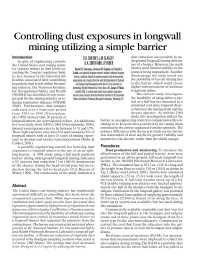Mining Publication: Controlling Dust Exposures in Longwall Mining Utilizing A Simple Barrier
Original creation date: December 2009
The United States coal mining industry has traditionally experienced difficulty in controlling dust levels below the occupational exposure limit. While improvements in face ventilation and water spray nozzles have decreased dust exposures, approximately eight percent of experienced coal miners are still developing Coal Workers Pneumoconiosis. This investigation tested the feasibility of enhancing existing engineering dust controls by mounting a simple barrier on a longwall shearer that separated the operators from the cutting drums. The barrier was constructed and tested above ground at the National Institute for Occupational Safety and Health Pittsburgh Research Laboratory longwall gallery test facility. A 96-percent reduction of respirable dust occurred at the headgate sampling position when tested at 2.4 m/sec (480 ft/min). The average dust level decreased from 39 mg/m3 to 1.5 mg/m3 by utilizing the barrier.
Authors: DD Sweeney, JM Slagley, DA Smith, JP Rider
Peer Reviewed Journal Article - December 2009
NIOSHTIC2 Number: 20036245
Min Eng 2009 Dec; 61(12):58-61
See Also
- Benchmarking Longwall Dust Control Technology and Practices
- Best Practices for Dust Control in Coal Mining
- Coal Dust Explosibility Meter Evaluation and Recommendations for Application
- Control of Respirable Dust
- Dust Control on Longwalls: Assessment of the State of the Art
- Evaluation of the Approach to Respirable Quartz Exposure Control in U.S. Coal Mines
- Evaluation of the Bagged Stone Dust Barrier Effectiveness in a Bord and Pillar Mine
- Improved Dust Control Methods for Longwall Mining
- Status of a Tapered Element, Oscillation Microbalance-Based Continuous Respirable Coal Mine Dust Monitor
- Suggestion of a Cause-and-Effect Relationship Among Coal Rank, Airborne Dust, and Incidence of Workers' Pneumoconiosis
- Content source: National Institute for Occupational Safety and Health, Mining Program


 ShareCompartir
ShareCompartir
